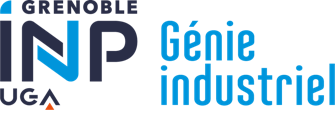Number of hours
- Lectures 13.5
- Projects -
- Tutorials 13.5
- Internship -
- Laboratory works 4.5
- Written tests -
ECTS
ECTS 3.0
Goal(s)
Know the basic principles of technical drawing and the representation of parts and systems in a 2D plan.
Understand assembly drawings and recognize the basic components of general mechanics (bearings, screws, axles, cogwheels, keys, etc.)
To know the principles and symbols of kinematics and know how to mobilize them for the production of kinematic representations.
Know how to make simplifying hypotheses and propose simple system models to then solve them.
Application in simple cases of general mechanics in the case of indeformable solids.
Master the elements of kinematic representation (input-output law).
The cases of resolution in statics (Fundamental Principle of Statics) will be approached in the following period.
Content(s)
The course is based on elements of kinematics behaviour of rigid bodies.
Presentation of concepts of motion, deformation and stress in continuum mechanics (area studied: deformable solids).
Presentation of how to determine and use these concepts in product design and process.
Hypotheses on strength of materials and classical solutions to strengths of materials.
Practical work:
- Application of the analysis methods of mechanical systmes (static behaviour and kinematics)
- Expérimentation and simulation, analysis and results comparison
- cad tool manipulation for simulation
- strengths of materials in the case of linear elasticity. Instrumentation and measurement.
General Mechanics and mathematics
Continuous assessment (CC) = the TP grade
Assessment session 1 (E1) = written exam (0.7) + TP mark (0.3)
Assessment session 2 (E2) = written or oral exam
NB = base score
N1 = final grade for session 1
N2 = final grade for session 2
The jury can decide to move on to a higher year, subject to deferred validation of this EU. This decision remains exceptional; the jury is sovereign for each student.
In the context of this present course, the attendance of a student can have an impact on the calculation of the continuous assessment mark: for example a penalty per absence, which can go up to zero in the CC in the event of repeated absences...).
The course exists in the following branches:
- Curriculum - Engineer IPID apprentice program - Semester 6
Course ID : 3GMA0913
Course language(s): 
You can find this course among all other courses.
"Guide de la mécanique" Jean Louis Fanchon edition Dunod 2008
French State controlled diploma conferring a Master's degree

Common Core presentation
Programme courses S5
Programme courses S6
Supply Chain Management
Programme presentation
Programme courses S7
Programme courses S8
Programme courses S9
Programme courses S10
Product Design
Programme presentation
Programme courses S7
Programme courses S8
Programme courses S9
Programme courses S10
Contacts
Academic staff
- Head of studies:
Pierre Lemaire - Head of 1st Year Program:
Abdourahim Sylla - Head of Supply Chain Management Program:
Irène Gannaz - Head of Product design Program:
Yann Ledoux
Registrar's office
- Head of Registrar's office:
genie-industriel.scolarite@grenoble-inp.fr - Secretary's office 1st Year:
Valérie Demicheli - Secretary's office 2nd Year:
Sylvie Malandrino - Secretary's office 3rd Year:
Vincente Odier - International relations department:
Nadia Dehemchi



